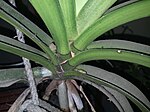Rhynchostylis retusa
| Rhynchostylis retusa | |
|---|---|

| |
| Scientific classification | |
| Kingdom: | Plantae |
| Clade: | Tracheophytes |
| Clade: | Angiosperms |
| Clade: | Monocots |
| Order: | Asparagales |
| Family: | Orchidaceae |
| Subfamily: | Epidendroideae |
| Subtribe: | Aeridinae |
| Genus: | Rhynchostylis |
| Species: | R. retusa
|
| Binomial name | |
| Rhynchostylis retusa | |
| Synonyms[1] | |
|
List
| |
Rhynchostylis retusa (also called foxtail orchid) is an orchid belonging to the Vanda alliance.[needs update] The inflorescence is a pendant raceme, consisting of more than 100 pink-spotted white flowers. The plant has a short, stout, creeping stem carrying up to 12, curved, fleshy, deeply channeled, keeled, retuse apically leaves and blooms on an axillary pendant to 60 cm (24 in) long, racemose, densely flowered, cylindrical inflorescence that occurs in the winter and early spring.
Distribution

The plant is an epiphyte growing on tree trunks in open forests or at forest margins at elevations of 300–1,500 m (980–4,920 ft). It can be found in Bhutan, Cambodia, China (Guizhou, Yunnan), India, Indonesia, Laos, Malaysia, Myanmar, Nepal, Philippines, Singapore, Sri Lanka, Thailand, and Vietnam.[2]
In India, the plant is most common in the Northeast, Odisha and Andhra Pradesh. In Andhra Pradesh, the plant is called by Telugu name Chintaranamu. Due to bio-piracy,[citation needed] the plant is on the verge of extinction in India. Rhynchostylis retusa is recognized as the state flower of Arunachal Pradesh and Assam in India,[3][4]: 245 as well as the provincial flower of Uva Province in Sri Lanka.[5]: 20

Care
The plant requires regular watering and applications of fertilizer throughout the year, although it will die if the leaves are wet frequently.[citation needed] It prefers indirect light. Flowering usually occurs in late spring.[6]
Medicinal uses
In
Significance in Assamese culture
The species is the state flower of Assam, where it is popularly known as kopou phool (Assamese: কপৌ ফুল), and is an integral part of a Bihu dancer's attire.[8] The plant is considered to be a symbol of love, fertility and merriment, and is popular in Assamese wedding ceremonies.[4]: 245
Gallery
-
Transformation of Rhynchostylis retusa from flower buds to seeds.
-
New Buds of Rhynchostylis retusa
-
New Buds of Rhynchostylis retusa
-
Buds of Rhynchostylis retusa
-
Buds of Rhynchostylis retusa
-
Buds of Rhynchostylis retusa
-
Buds of Rhynchostylis retusa
-
Flowers of Rhynchostylis retusa
-
Flowers of Rhynchostylis retusa
-
Flowers of Rhynchostylis retusa
-
Flowers of Rhynchostylis retusa
-
New fruits of Rhynchostylis retusa
-
New fruits of Rhynchostylis retusa
-
New fruits of Rhynchostylis retusa
-
Fruits of Rhynchostylis retusa
-
Fruits of Rhynchostylis retusa
-
Fruits of Rhynchostylis retusa
-
Matured fruits of Rhynchostylis retusa
-
Matured fruits of Rhynchostylis retusa
-
Matured fruits of Rhynchostylis retusa
-
New roots of Rhynchostylis retusa
-
Flowers of Rhynchostylis retusa
References
- ^ a b "Rhynchostylis retusa (L.) Blume". Plants of the World Online. Royal Botanic Gardens, Kew. Retrieved 8 February 2025.
- ^ Chen, Xingi; Wood, Jeffrey J. "Rhynchostylis retusa". Flora of China. Retrieved 28 April 2018 – via eFloras.org, Missouri Botanical Garden, St. Louis, MO & Harvard University Herbaria, Cambridge, MA.
- ^ "Official tag on Bihu-linked orchid - Assam government includes kopou phul, rhino in list of state symbols". The Telegraph. 4 April 2003. Archived from the original on 7 February 2025.
- ^ ISBN 978-94-007-7055-3.
- S2CID 128071809.
- from the original on 9 October 2024.
- ISBN 978-0-8014-1512-8.
- ^ Rahman, Azera Parveen (3 July 2023). "Orchids are blooming earlier than usual in the northeast — and it's not good news". Mongabay. Archived from the original on 17 December 2024.
External links
 Media related to Rhynchostylis retusa (category) at Wikimedia Commons
Media related to Rhynchostylis retusa (category) at Wikimedia Commons Data related to Rhynchostylis retusa at Wikispecies
Data related to Rhynchostylis retusa at Wikispecies





















